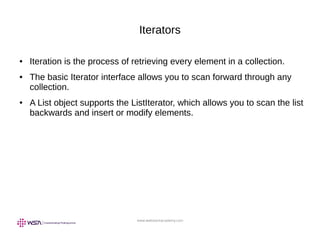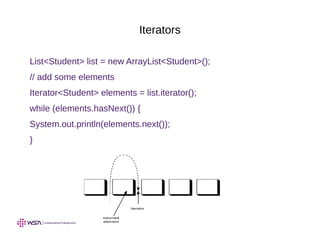Core Java Programming Language (JSE) : Chapter IX - Collections and Generic Framework
- 1. www.webstackacademy.com Java Programming Language SE – 6 Module 9:Collections and Generics Framework
- 2. www.webstackacademy.com Objectives ● Describe the Collections ● Describe the general purpose implementations of the core interfaces in the Collections framework ● Examine the Map interface ● Examine the legacy collection classes ● Create natural and custom ordering by implementing the Comparable and Comparator interfaces ● Use generic collections ● Use type parameters in generic classes ● Refactor existing non-generic code ● Write a program to iterate over a collection ● Examine the enhanced for loop
- 3. www.webstackacademy.com The Collections API ● A collection is a single object managing a group of objects known as its elements. ● The Collections API contains interfaces that group objects as one of the following: ● Collection – A group of objects called elements; implementations determine whether there is specific ordering and whether duplicates are permitted. ● Set – An unordered collection; no duplicates are permitted. ● List – An ordered collection; duplicates are permitted.
- 5. www.webstackacademy.com Collection Implementations ● There are several general purpose implementations of the core interfaces (Set, List, Deque and Map)
- 6. www.webstackacademy.com A Set Example import java.util.*; public class SetExample { public static void main(String[] args) { Set set = new HashSet(); set.add("one"); set.add("second"); set.add("3rd"); set.add(new Integer(4)); set.add(new Float(5.0F)); // duplicate, not added set.add("second");// duplicate, not added set.add(new Integer(4)); // duplicate, not added System.out.println(set); }
- 7. www.webstackacademy.com A Set Example The output generated from this program is: [one, second, 5.0, 3rd, 4]
- 8. www.webstackacademy.com A List Example import java.util.* public class ListExample { public static void main(String[] args) { List list = new ArrayList(); list.add("one"); list.add("second"); list.add("3rd"); list.add(new Integer(4)); list.add(new Float(5.0F)); // duplicate, is added list.add("second");//duplicate, is added list.add(new Integer(4)); // duplicate, is added System.out.println(list); }}
- 9. www.webstackacademy.com A List Example ● The output generated from this program is: ● [one, second, 3rd, 4, 5.0, second, 4]
- 10. www.webstackacademy.com The Map Interface ● Maps are sometimes called associative arrays ● A Map object describes mappings from keys to values: ● Duplicate keys are not allowed ● One-to-many mappings from keys to values is not permitted
- 11. www.webstackacademy.com The Map Interface ● The contents of the Map interface can be viewed and manipulated as collections ● entrySet – Returns a Set of all the key-value pairs. ● keySet – Returns a Set of all the keys in the map. ● values – Returns a Collection of all values in the map
- 13. www.webstackacademy.com A Map Example public static void main(String args[]) { Map map = new HashMap(); map.put("one","1st"); map.put("second", new Integer(2)); map.put("third","3rd"); map.put("third","III"); Set set1 = map.keySet(); Collection collection = map.values(); Set set2 = map.entrySet(); System.out.println(set1 + "n" + collection + "n" + set2); }
- 14. www.webstackacademy.com A Map Example Output generated from the MapExample program: [second, one, third] [2, 1st, III] [second=2, one=1st, third=III]
- 15. www.webstackacademy.com Legacy Collection Classes Collections in the JDK include: ● The Vector class, which implements the List interface. ● The Stack class, which is a subclass of the Vector class and supports the push, pop, and peek methods. ● The Hashtable class, which implements the Map interface. ● The Properties class is an extension of Hashtable that only uses Strings for keys and values. ● Each of these collections has an elements method that returns an Enumeration object. The Enumeration interface is incompatible with, the Iterator interface.
- 16. www.webstackacademy.com Ordering Collections The Comparable and Comparator interfaces are useful for ordering collections: ● The Comparable interface imparts natural ordering to classes that implement it. ● The Comparator interface specifies order relation. It can also be used to override natural ordering. ● Both interfaces are useful for sorting collections.
- 17. www.webstackacademy.com The Comparable Interface Imparts natural ordering to classes that implement it: ● Used for sorting ● The compareTo method should be implemented to make any class comparable: ● int compareTo(Object o) method ● The String, Date, and Integer classes implement the Comparable interface ● You can sort the List elements containing objects that implement the Comparable interface
- 18. www.webstackacademy.com The Comparable Interface ● While sorting, the List elements follow the natural ordering of the element types – String elements – Alphabetical order – Date elements – Chronological order – Integer elements – Numerical order
- 19. www.webstackacademy.com Example of the Comparable Interface class Student implements Comparable { String firstName, lastName; int studentID=0; double GPA=0.0; public Student(String firstName, String lastName, int studentID, double GPA) { if (firstName == null || lastName == null || studentID == 0 || GPA == 0.0) {throw new IllegalArgumentException();} this.firstName = firstName; this.lastName = lastName; this.studentID = studentID; this.GPA = GPA; }
- 20. www.webstackacademy.com Example of the Comparable Interface public String firstName() { return firstName; } public String lastName() { return lastName; } public int studentID() { return studentID; } public double GPA() { return GPA; } public int compareTo(Object o) { double f = GPA-((Student)o).GPA; if (f == 0.0) return 0; else if (f<0.0) return -1; else return 1; }}
- 21. www.webstackacademy.com Example of the Comparable Interface public static void main(String[] args) { TreeSet studentSet = new TreeSet(); studentSet.add(new Student("Mike", "Hauffmann",101,4.0)); studentSet.add(new Student("John", "Lynn",102,2.8 )); studentSet.add(new Student("Jim", "Max",103, 3.6)); studentSet.add(new Student("Kelly", "Grant",104,2.3)); Object[] studentArray = studentSet.toArray(); Student s; for(Object obj : studentArray){ s = (Student) obj; System.out.printf("Name = %s %s ID = %d GPA = %.1fn", s.firstName(), s.lastName(), s.studentID(), s.GPA()); }}
- 22. www.webstackacademy.com Example of the Comparable Interface Generated Output: Name = Kelly Grant ID = 104 GPA = 2.3 Name = John Lynn ID = 102 GPA = 2.8 Name = Jim Max ID = 103 GPA = 3.6 Name = Mike Hauffmann ID = 101 GPA = 4.0
- 23. www.webstackacademy.com The Comparator Interface ● Represents an order relation ● Used for sorting ● Enables sorting in an order different from the natural order ● Used for objects that do not implement the Comparable interface ● Can be passed to a sort method ● You need the compare method to implement the Comparator interface: – int compare(Object o1, Object o2) method
- 24. www.webstackacademy.com Example of the Comparator Interface class Student { String firstName, lastName; int studentID=0; double GPA=0.0; public Student(String firstName, String lastName, int studentID, double GPA) { if (firstName == null || lastName == null || studentID == 0 || GPA == 0.0) throw new NullPointerException(); this.firstName = firstName;this.lastName = lastName;this.studentID = studentID; this.GPA = GPA; } public String firstName() { return firstName; }public String lastName() { return lastName; } public int studentID() { return studentID; } public double GPA() { return GPA; } }
- 25. www.webstackacademy.com Example of the Comparator Interface public class NameComp implements Comparator { public int compare(Object o1, Object o2) { return (((Student)o1).firstName.compareTo(((Student)o2).firstName)); }} public class GradeComp implements Comparator { public int compare(Object o1, Object o2) { if (((Student)o1).GPA == ((Student)o2).GPA) return 0; else if (((Student)o1).GPA < ((Student)o2).GPA) return -1; else return 1; }}
- 26. www.webstackacademy.com Example of the Comparator Interface public class ComparatorTest { public static void main(String[] args) { Comparator c = new NameComp(); TreeSet studentSet = new TreeSet(c); studentSet.add(new Student("Mike", "Hauffmann",101,4.0)); studentSet.add(new Student("John", "Lynn",102,2.8 )); studentSet.add(new Student("Jim", "Max",103, 3.6)); studentSet.add(new Student("Kelly", "Grant",104,2.3)); Object[] studentArray = studentSet.toArray(); Student s; for(Object obj : studentArray) { s = (Student) obj; System.out.println("Name = %s %s ID = %d GPA = %.1fn", s.firstName(), s.lastName(), s.studentID(), s.GPA()); }}
- 27. www.webstackacademy.com Example of the Comparator Interface The output: Name =Jim Max ID = 0 GPA = 3.6 Name = John Lynn ID = 0 GPA = 2.8 Name = Kelly Grant ID = 0 GPA = 2.3 Name = Mike Hauffmann ID = 0 GPA = 4.0
- 28. www.webstackacademy.com Generics Generics are described as follows: ● Provide compile-time type safety ● Eliminate the need for casts ● Provide the ability to create compiler-checked homogeneous collections
- 29. www.webstackacademy.com Generics ● Using non-generic collections: ArrayList list = new ArrayList(); list.add(0, new Integer(42)); int total = ((Integer)list.get(0)).intValue(); ● Using generic collections: ArrayList<Integer> list = new ArrayList<Integer>(); list.add(0, new Integer(42)); int total = list.get(0).intValue();
- 30. www.webstackacademy.com Generic Set Example import java.util.*; public class GenSetExample { public static void main(String[] args) { Set<String> set = new HashSet<String>(); set.add("one"); set.add("second"); set.add("3rd"); set.add(new Integer(4)); set.add("second"); System.out.println(set); }}
- 31. www.webstackacademy.com Generic Map Example public class MapPlayerRepository { HashMap<String, String> players; public MapPlayerRepository() { players = new HashMap<String, String> (); } public String get(String position) { String player = players.get(position); return player; } public void put(String position, String name) { players.put(position, name); }
- 34. www.webstackacademy.com Wild Card Type Parameters
- 35. www.webstackacademy.com The Type-Safety Guarantee public class TestTypeSafety { public static void main(String[] args) { List<CheckingAccount> lc = new ArrayList<CheckingAccount>(); lc.add(new CheckingAccount("Fred")); // OK lc.add(new SavingsAccount("Fred")); // Compile error! CheckingAccount ca = lc.get(0); } }
- 36. www.webstackacademy.com The Invariance Challenge List<Account> la; List<CheckingAccount> lc = new ArrayList<CheckingAccount>(); List<SavingsAccount> ls = new ArrayList<SavingsAccount>(); la = lc; la.add(new CheckingAccount("Fred")); la = ls; la.add(new CheckingAccount("Fred")); SavingsAccount sa = ls.get(0); //aarrgghh!!
- 37. www.webstackacademy.com The Invariance Challenge In fact, la=lc; is illegal, so even though a CheckingAccount is an Account, an ArrayList<CheckingAccount> is not an ArrayList<Account>.
- 38. www.webstackacademy.com The Covariance Response public static void printNames(List <? extends Account> lea) { for (int i=0; i < lea.size(); i++) { System.out.println(lea.get(i).getName()); } } public static void main(String[] args) { List<CheckingAccount> lc = new ArrayList<CheckingAccount>(); List<SavingsAccount> ls = new ArrayList<SavingsAccount>(); printNames(lc); printNames(ls); List<? extends Object> leo = lc; //OK leo.add(new CheckingAccount("Fred"));//Compile error! }}
- 39. www.webstackacademy.com Generics: Refactoring Existing Non-Generic Code import java.util.*; public class GenericsWarning { public static void main(String[] args) { List list = new ArrayList(); list.add(0, new Integer(42)); int total = ((Integer)list.get(0).intValue(); }}
- 40. www.webstackacademy.com Generics: Refactoring Existing Non-Generic Code ● javac GenericsWarning.java Note: GenericsWarning.java uses unchecked or unsafe operations. Note: Recompile with -Xlint:unchecked for details. ● javac -Xlint:unchecked GenericsWarning.java GenericsWarning.java:7: warning: [unchecked] unchecked call to add(int,E) as a member of the raw type java.util.ArrayList list.add(0, new Integer(42)); 1 warning
- 41. www.webstackacademy.com Iterators ● Iteration is the process of retrieving every element in a collection. ● The basic Iterator interface allows you to scan forward through any collection. ● A List object supports the ListIterator, which allows you to scan the list backwards and insert or modify elements.
- 42. www.webstackacademy.com Iterators List<Student> list = new ArrayList<Student>(); // add some elements Iterator<Student> elements = list.iterator(); while (elements.hasNext()) { System.out.println(elements.next()); }
- 44. www.webstackacademy.com The Enhanced for Loop ● The enhanced for loop has the following characteristics: – Simplified iteration over collections – Much shorter, clearer, and safer – Effective for arrays – Simpler when using nested loops – Iterator disadvantages removed ● Iterators are error prone: – Iterator variables occur three times per loop. – This provides the opportunity for code to go wrong.
- 45. www.webstackacademy.com The Enhanced for Loop An enhanced for loop can look like the following: ● Using the iterator with a traditional for loop: public void deleteAll(Collection<NameList> c){ for ( Iterator<NameList> i = c.iterator() ; i.hasNext() ; ){ NameList nl = i.next(); nl.deleteItem(); }}
- 46. www.webstackacademy.com The Enhanced for Loop ● Iterating using an enhanced for loop in collections: public void deleteAll(Collection<NameList> c){ for ( NameList nl : c ){ nl.deleteItem(); }}
- 47. www.webstackacademy.com The Enhanced for Loop ● Nested enhanced for loops: List<Subject> subjects=...; List<Teacher> teachers=...; List<Course> courseList = ArrayList<Course)(); for (Subject subj: subjects) { for (Teacher tchr: teachers) { courseList.add(new Course(subj, tchr)); }}
- 48. www.webstackacademy.com Web Stack Academy (P) Ltd #83, Farah Towers, 1st floor,MG Road, Bangalore – 560001 M: +91-80-4128 9576 T: +91-98862 69112 E: [email protected]






![www.webstackacademy.com
A Set Example
import java.util.*;
public class SetExample {
public static void main(String[] args) {
Set set = new HashSet();
set.add("one");
set.add("second");
set.add("3rd");
set.add(new Integer(4));
set.add(new Float(5.0F));
// duplicate, not added
set.add("second");// duplicate, not added
set.add(new Integer(4)); // duplicate, not added
System.out.println(set);
}](https://image.slidesharecdn.com/009javasecollectionsgenerics-190430062641/85/Core-Java-Programming-Language-JSE-Chapter-IX-Collections-and-Generic-Framework-6-320.jpg)
![www.webstackacademy.com
A Set Example
The output generated from this program is:
[one, second, 5.0, 3rd, 4]](https://image.slidesharecdn.com/009javasecollectionsgenerics-190430062641/85/Core-Java-Programming-Language-JSE-Chapter-IX-Collections-and-Generic-Framework-7-320.jpg)
![www.webstackacademy.com
A List Example
import java.util.*
public class ListExample {
public static void main(String[] args) {
List list = new ArrayList();
list.add("one");
list.add("second");
list.add("3rd");
list.add(new Integer(4));
list.add(new Float(5.0F));
// duplicate, is added
list.add("second");//duplicate, is added
list.add(new Integer(4)); // duplicate, is added
System.out.println(list);
}}](https://image.slidesharecdn.com/009javasecollectionsgenerics-190430062641/85/Core-Java-Programming-Language-JSE-Chapter-IX-Collections-and-Generic-Framework-8-320.jpg)
![www.webstackacademy.com
A List Example
● The output generated from this program is:
● [one, second, 3rd, 4, 5.0, second, 4]](https://image.slidesharecdn.com/009javasecollectionsgenerics-190430062641/85/Core-Java-Programming-Language-JSE-Chapter-IX-Collections-and-Generic-Framework-9-320.jpg)



![www.webstackacademy.com
A Map Example
public static void main(String args[]) {
Map map = new HashMap();
map.put("one","1st");
map.put("second", new Integer(2));
map.put("third","3rd");
map.put("third","III");
Set set1 = map.keySet();
Collection collection = map.values();
Set set2 = map.entrySet();
System.out.println(set1 + "n" + collection + "n" + set2);
}](https://image.slidesharecdn.com/009javasecollectionsgenerics-190430062641/85/Core-Java-Programming-Language-JSE-Chapter-IX-Collections-and-Generic-Framework-13-320.jpg)
![www.webstackacademy.com
A Map Example
Output generated from the MapExample program:
[second, one, third]
[2, 1st, III]
[second=2, one=1st, third=III]](https://image.slidesharecdn.com/009javasecollectionsgenerics-190430062641/85/Core-Java-Programming-Language-JSE-Chapter-IX-Collections-and-Generic-Framework-14-320.jpg)


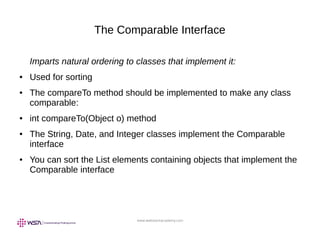
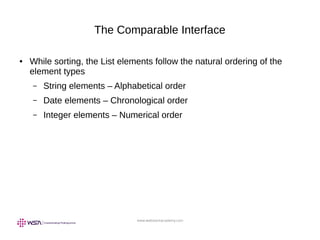


![www.webstackacademy.com
Example of the
Comparable Interface
public static void main(String[] args) {
TreeSet studentSet = new TreeSet();
studentSet.add(new Student("Mike", "Hauffmann",101,4.0));
studentSet.add(new Student("John", "Lynn",102,2.8 ));
studentSet.add(new Student("Jim", "Max",103, 3.6));
studentSet.add(new Student("Kelly", "Grant",104,2.3));
Object[] studentArray = studentSet.toArray();
Student s;
for(Object obj : studentArray){
s = (Student) obj;
System.out.printf("Name = %s %s ID = %d GPA = %.1fn",
s.firstName(), s.lastName(), s.studentID(), s.GPA());
}}](https://image.slidesharecdn.com/009javasecollectionsgenerics-190430062641/85/Core-Java-Programming-Language-JSE-Chapter-IX-Collections-and-Generic-Framework-21-320.jpg)




![www.webstackacademy.com
Example of the
Comparator Interface
public class ComparatorTest {
public static void main(String[] args) {
Comparator c = new NameComp();
TreeSet studentSet = new TreeSet(c);
studentSet.add(new Student("Mike", "Hauffmann",101,4.0));
studentSet.add(new Student("John", "Lynn",102,2.8 ));
studentSet.add(new Student("Jim", "Max",103, 3.6));
studentSet.add(new Student("Kelly", "Grant",104,2.3));
Object[] studentArray = studentSet.toArray();
Student s;
for(Object obj : studentArray) {
s = (Student) obj;
System.out.println("Name = %s %s ID = %d GPA = %.1fn",
s.firstName(), s.lastName(), s.studentID(), s.GPA());
}}](https://image.slidesharecdn.com/009javasecollectionsgenerics-190430062641/85/Core-Java-Programming-Language-JSE-Chapter-IX-Collections-and-Generic-Framework-26-320.jpg)
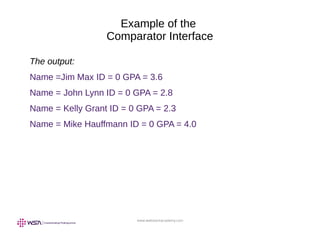


![www.webstackacademy.com
Generic Set Example
import java.util.*;
public class GenSetExample {
public static void main(String[] args) {
Set<String> set = new HashSet<String>();
set.add("one");
set.add("second");
set.add("3rd");
set.add(new Integer(4));
set.add("second");
System.out.println(set);
}}](https://image.slidesharecdn.com/009javasecollectionsgenerics-190430062641/85/Core-Java-Programming-Language-JSE-Chapter-IX-Collections-and-Generic-Framework-30-320.jpg)


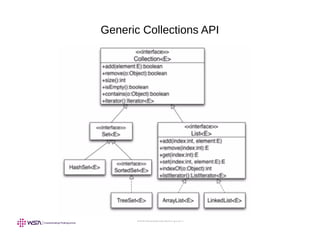

![www.webstackacademy.com
The Type-Safety Guarantee
public class TestTypeSafety {
public static void main(String[] args) {
List<CheckingAccount> lc = new ArrayList<CheckingAccount>();
lc.add(new CheckingAccount("Fred")); // OK
lc.add(new SavingsAccount("Fred")); // Compile error!
CheckingAccount ca = lc.get(0);
}
}](https://image.slidesharecdn.com/009javasecollectionsgenerics-190430062641/85/Core-Java-Programming-Language-JSE-Chapter-IX-Collections-and-Generic-Framework-35-320.jpg)

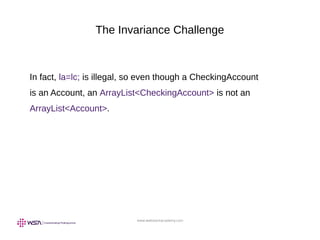
![www.webstackacademy.com
The Covariance Response
public static void printNames(List <? extends Account> lea) {
for (int i=0; i < lea.size(); i++) {
System.out.println(lea.get(i).getName());
}
}
public static void main(String[] args) {
List<CheckingAccount> lc = new ArrayList<CheckingAccount>();
List<SavingsAccount> ls = new ArrayList<SavingsAccount>();
printNames(lc);
printNames(ls);
List<? extends Object> leo = lc; //OK
leo.add(new CheckingAccount("Fred"));//Compile error!
}}](https://image.slidesharecdn.com/009javasecollectionsgenerics-190430062641/85/Core-Java-Programming-Language-JSE-Chapter-IX-Collections-and-Generic-Framework-38-320.jpg)
![www.webstackacademy.com
Generics: Refactoring
Existing Non-Generic Code
import java.util.*;
public class GenericsWarning {
public static void main(String[] args) {
List list = new ArrayList();
list.add(0, new Integer(42));
int total = ((Integer)list.get(0).intValue();
}}](https://image.slidesharecdn.com/009javasecollectionsgenerics-190430062641/85/Core-Java-Programming-Language-JSE-Chapter-IX-Collections-and-Generic-Framework-39-320.jpg)
![www.webstackacademy.com
Generics: Refactoring
Existing Non-Generic Code
● javac GenericsWarning.java
Note: GenericsWarning.java uses unchecked or unsafe operations.
Note: Recompile with -Xlint:unchecked for details.
● javac -Xlint:unchecked GenericsWarning.java
GenericsWarning.java:7: warning: [unchecked] unchecked call to
add(int,E) as a member of the raw type java.util.ArrayList
list.add(0, new Integer(42));
1 warning](https://image.slidesharecdn.com/009javasecollectionsgenerics-190430062641/85/Core-Java-Programming-Language-JSE-Chapter-IX-Collections-and-Generic-Framework-40-320.jpg)
